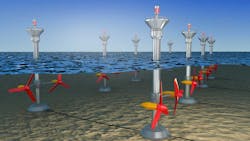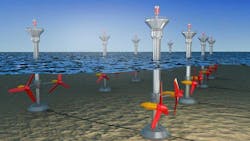Harnessing the Power of Tidal Energy
Members can download this article in PDF format.
What you'll learn:
- Potential benefits of tidal energy as a renewable-energy source.
- What is a tidal barrage power system?
- U.K. efforts to implement tidal power.
A major source of tidal energy comes from the natural rise and fall of the Earth’s oceans due to the gravitational interaction between the Sun, the Earth, and the Moon. As opposed to solar and wind power, tidal energy is far more predictable. Major disadvantages of tidal energy, though, are a scarcity of available ocean sources that have high flow velocity or high tidal ranges.
The good news is recent technological advances and knowledge in design (e.g., dynamic tidal power and tidal lagoons) and turbine technology (e.g., new axial turbines and cross flow turbines) show that the total availability of tidal power may be much higher than once thought. As a bonus, environmental and economic costs may now be able to be lowered to more competitive levels.
Tidal currents, with sufficient energy, could be used in harvesting as the water passes through a narrowing region of flow, thus accelerating the water velocity. Exclusive generators, set in strategic locations, would convert tidal energy into electrical power quite easily. Ocean wave motion or currents, along with differences in the temperature or salinity of the sea water, are able to generate energy as well.
Many of the ideal locations to capture tidal energy experience large differences in tidal range (i.e, the difference between high and low tides). Areas with constricted tidal channels and waterways will generally see more powerful tidal flow.
The U.S. Department of Energy (DoE) claims that tidal, wave, and ocean current energy have a combined potential to generate sufficient electricity to power millions of industries and residential homes.
Because water is denser than the air surrounding us, tidal energy is more powerful than wind energy. Thus, exponentially more power can be produced at the same turbine diameter and rotor speed. Another advantage of tidal power is that it’s far more consistent and predictable than either solar or wind energy. This is due to the intermittent nature of both solar and wind.
When tidal energy is made commercially available to capture and convert energy into usable power at scale, as well as finding even more uses of tidal energy, costs will become less sensitive than the National Grid energy.
The Tidal Barrage
To generate reliable energy, tidal power needs a very powerful flow of water. One way to capture this power is when water flows through a narrow channel, like an estuary. An estuary is a partially enclosed coastal body of lightly salted water with one or more rivers or streams flowing into it; a free connection to the open sea helps this effort. Estuaries form a transition zone between river environments and maritime.
Early attempts at tidal power plants employed a dam-like barrage method. This attempt didn’t last very long. Some other previous attempts also proved not viable. The good news is that a large tidal barrage was created in the city of La Rance, France in 1966, and is still in operation today.
La Rance Tidal Power Barrage
The Tidal Power Barrage will generate electricity with traffic traveling along the road on top of it. This was built on the Rance river in France. The barrage opens sluice gates when the tide is rising to fill the estuary (Fig. 1) that acts as a reservoir. When the tide falls, the sluice gates are closed, and the water is released only through the 24 turbine generators.
This dam is located at a point where the tidal range will reach up to 13.5 meters. It is 750 meters long and creates an artificial lake of 22 square kilometers. The generators can produce a total of 240 million watts of power!
Tidal Power and the U.K. Government
In 2021, the United Kingdom’s government initiated the largest investment, in a generation, for tidal power. The goals of this effort are to strengthen energy security and create numerous jobs within the tidal power industry. The U.K. is committed to building a strong, renewable-energy sector to reduce the country’s dependence on fossil fuels.
Scottish Secretary Alister Jack commented, “This U.K. Government allocation of funding for the tidal industry in Scotland, and across the U.K., is tremendous news. Harnessing the powers of our seas is a vital step in our transition to the use of greener, cleaner energy and underlines the U.K. Government’s commitment to create and protect highly skilled jobs while on our journey to Net Zero by 2050.
“With strong wind and solar power industries in the U.K., it is the natural next step to explore our tidal energy capabilities. It’s an exciting development in supporting of our domestically produced renewable-energy sources.”
Tidal Stream Generators
The power available for tidal power generation in a given area may be greater than a wind turbine due to the higher density of water. A tidal stream generator is shown in Figure 2.
The Possibilities of Tidal Energy
Tidal power offers quite a unique source of renewable energy. When there’s a difference in area between high tide and low tide, it allows for a very positive and powerful generation of electricity. On top of that, there’s a machine that can convert one kind of energy to another, such as by changing mechanical energy into electricity, further lending credence to the possibilities of tidal energy.
References
UK government announces biggest investment into Britain’s tidal power, November 24, 2021.
Tidal energy, BBC.
About the Author

Steve Taranovich
Freelance Technical Writer, Phoenix Information Communication LLC
Steve is a contributing editor to Electronic Design.
Author of the non-fiction “Guardians of the Right Stuff,” a true story of the Apollo program as told by NASA and Grumman Corp. engineers, an astronaut, and technicians.
Experienced Editor-In-Chief of EETimes/Planet Analog and Senior Technical Editor at EDN running the Analog and Power Management Design Centers from 2012 to 2019.
A demonstrated history in electronic circuit design and applications for 40 years, and nine years of technical writing and editing in industry. Skilled in Analog Electronics, Space-related Electronics, Audio, RF & Communications, Power Management, Electrical Engineering, and Integrated Circuits (IC).
1972 to 1988 worked as a circuit design engineer in audio (8 years) and microwave (8 years). Then was Corporate Account Manager/applications engineer for Burr-Brown from 1988 to 2000 when TI purchased Burr-Brown. Worked for TI from 2000 to 2011.
Strong media and communication professional with a BEEE from NYU Engineering in 1972 and an MSEE from Polytechnic University in 1989. Senior Lifetime member of IEEE. Former IEEE Long Island, NY Director of Educational Activities. Eta Kappa Nu EE honor society member since 1970.

![1. Shown is the tidal turbine used in France’s La Rance Tidal Power Barrage. (Adapted from National Energy Education Development Project [public domain]) 1. Shown is the tidal turbine used in France’s La Rance Tidal Power Barrage. (Adapted from National Energy Education Development Project [public domain])](https://img.electronicdesign.com/files/base/ebm/electronicdesign/image/2024/01/6596c0e76a8396001e70754f-fig1.png?auto=format,compress&fit=max&q=45?w=250&width=250)
